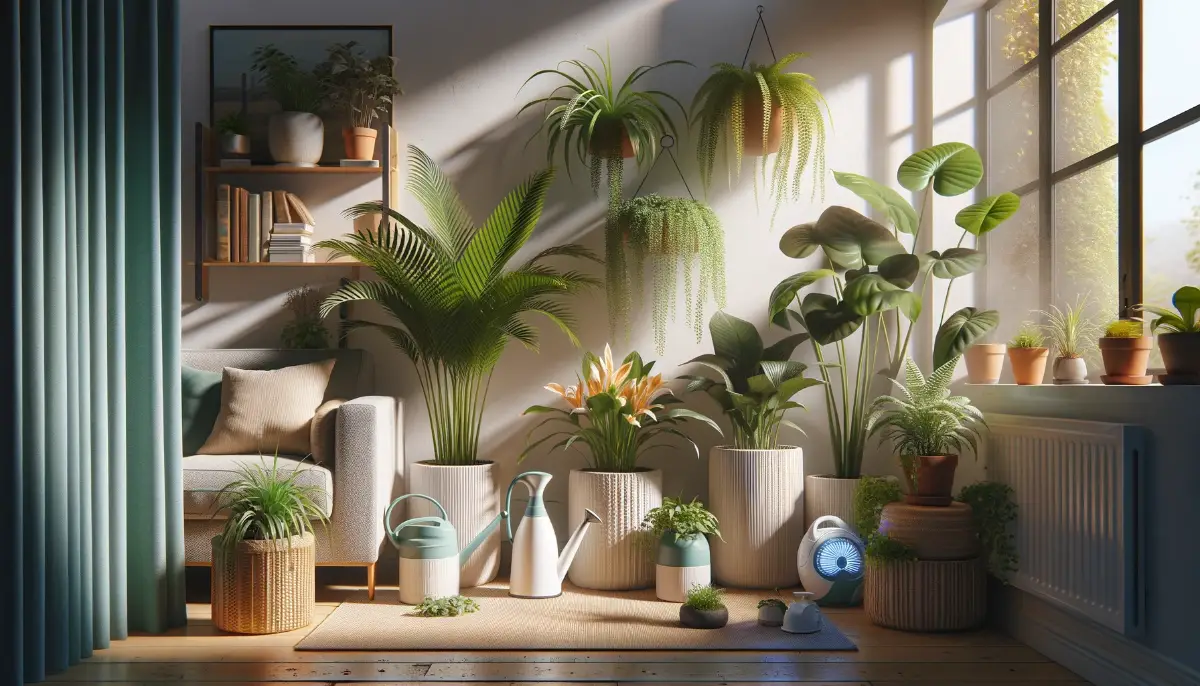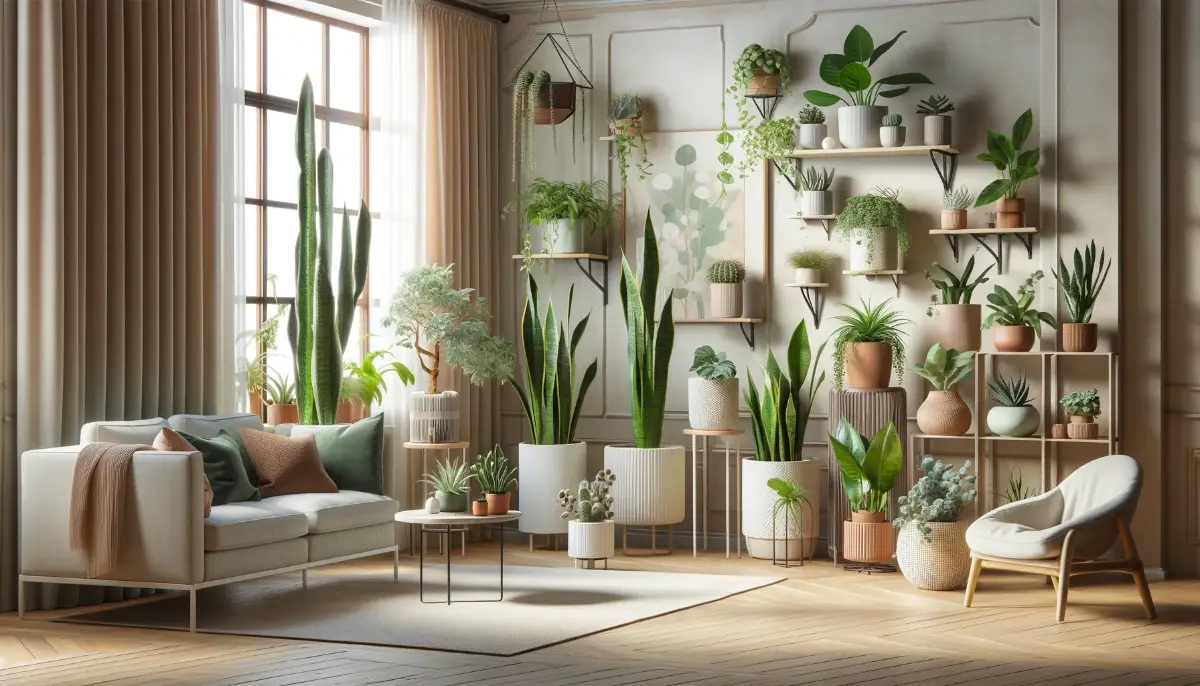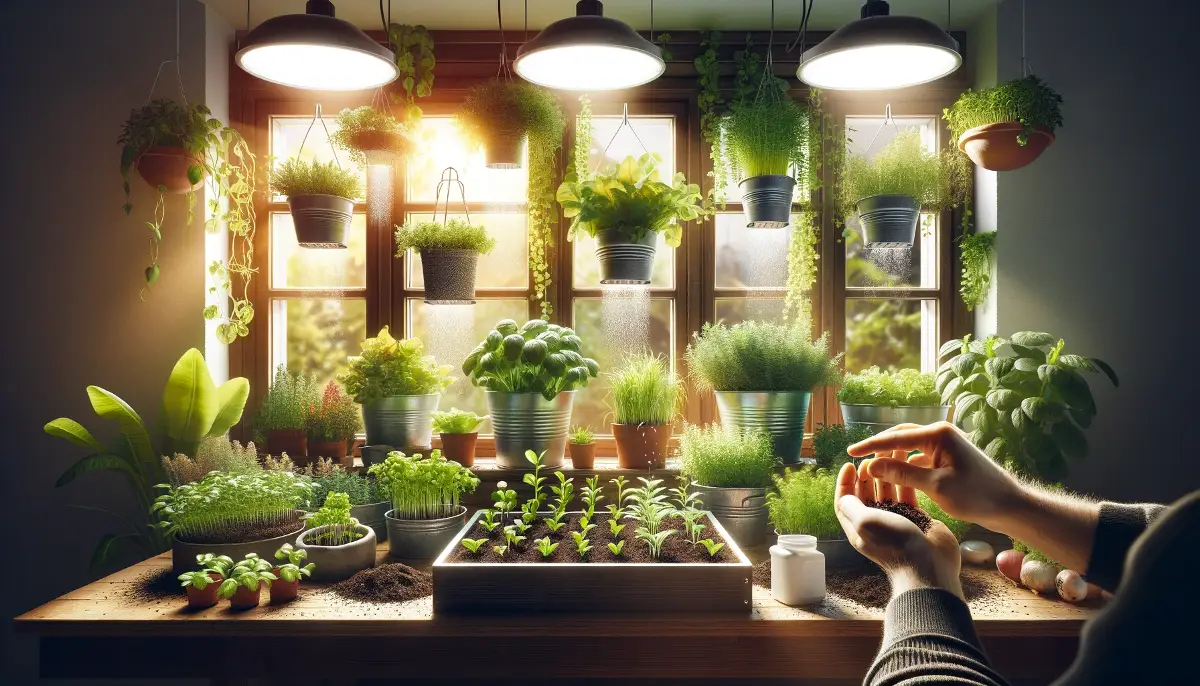Houseplants can naturally increase indoor humidity through transpiration, where they release moisture into the air, thus acting as natural humidifiers. This symbiotic relationship enhances both indoor air quality and the living environment.
The Best 5 Houseplants that Increase Humidity
Having humidity-boosting plants at home is beneficial because they naturally increase indoor moisture levels, which can improve respiratory health, skin hydration, and overall comfort. Additionally, these plants help purify the air by removing toxins, contributing to a healthier living environment.
They also enhance the aesthetic appeal of your space, bringing a bit of nature indoors, which has been shown to reduce stress and improve mood. These plants not only help in improving air quality but also contribute to a healthier living environment by adding necessary humidity, which is beneficial during dry seasons or in air-conditioned spaces.
Boston Fern (Nephrolepis exaltata)
- Humidity Contribution: Known for its lush, feathery fronds, the Boston Fern releases a significant amount of moisture into the air, making it ideal for increasing indoor humidity levels.
- Air Purification: Beyond its humidifying capabilities, the Boston Fern is also recognized for its ability to purify the air by removing common household toxins.
Areca Palm (Dypsis lutescens)
- Humidity Addition: The Areca Palm is not only decorative but also excellent at adding moisture to the indoor environment, thanks to its extensive fronds.
- Decorative Appeal: With its feathery, arching fronds, the Areca Palm adds a tropical flair to any room, alongside its environmental benefits.
Spider Plant (Chlorophytum comosum)
- Moisture Release: The Spider Plant is efficient at releasing moisture into the air, which can help increase humidity levels in your home.
- Ease of Care: This plant is incredibly hardy and easy to care for, making it ideal for beginners. It’s also known for its air-purifying properties, removing toxins such as formaldehyde and xylene.
Peace Lily (Spathiphyllum)
- Humidity Support: The Peace Lily contributes to indoor humidity through its transpiration process, making it a great choice for dry environments.
- Air Purification and Beauty: It not only helps with humidity but also filters out harmful toxins from the air. The Peace Lily is also prized for its beautiful white blooms that add elegance to any space.
Rubber Plant (Ficus elastica)
- Moisture Addition: The Rubber Plant is capable of increasing humidity within your home through the large surface area of its leaves.
- Visual Appeal: It offers a striking aesthetic with its glossy, dark green leaves, and is known for being particularly effective at removing air pollutants.
Care for Maximum Effectiveness
Caring for houseplants that can increase the humidity in your home involves a few key practices to ensure they thrive and effectively release moisture into the air. Here are some general care and maintenance tips for these types of plants:
Watering
- Consistency is Key: These plants often thrive in consistently moist soil. Check the topsoil regularly (about an inch deep) and water once it starts to feel dry. Avoid letting the soil dry out completely.
- Quality of Water: Use room-temperature water to avoid shocking the plant’s roots. Rainwater or distilled water can be beneficial for plants sensitive to chemicals in tap water.
Light Requirements
- Indirect Light: Most humidity-loving plants prefer bright, indirect sunlight. Direct sun can scorch their leaves, while too little light can hinder their growth and moisture absorption capabilities.
- Rotate Your Plants: Rotate your plants regularly to ensure even light distribution, promoting balanced growth and health.
Humidity and Temperature
- Increase Local Humidity: For plants that thrive in high humidity, such as ferns and orchids, increase local humidity by misting the leaves, placing a humidity tray underneath the pot, or using a humidifier in the room.
- Ideal Temperature: Keep these plants in warm conditions, generally between 65°F and 75°F during the day, and slightly cooler at night. Avoid placing them near drafts or heating vents.
Soil and Repotting
- Well-Draining Soil: Use a well-draining potting mix suitable for the specific type of plant. Some may benefit from added perlite or orchid bark to improve drainage.
- Repotting: Repot your plants every couple of years or when they outgrow their current pots. This refreshes the soil and provides room for growth.
Find more tips for When and How to Repot Your Indoor Plants
Pruning and Cleaning
- Remove Dead Foliage: Regularly prune dead or yellowing leaves to encourage new growth and improve air circulation around the plant.
- Clean Leaves: Wipe down leaves with a damp cloth to remove dust, ensuring the plant can effectively absorb light and perform photosynthesis.
Fertilizing
- Balanced Fertilizer: Use a balanced, water-soluble fertilizer during the growing season (spring through summer), following the package instructions for dilution and frequency. Over-fertilizing can harm the plant, so it’s essential to fertilize moderately.
Read more: How to Fertilize Organic Indoor Garden Plants
Pest and Disease Management
- Regular Inspection: Check your plants for signs of pests and diseases regularly. Treat infestations early with insecticidal soap or neem oil and isolate affected plants to prevent spread.
By following these care and maintenance tips, you can ensure your humidity-increasing houseplants remain healthy and effective at adding moisture to your indoor environment. Remember, the specific care requirements can vary significantly from plant to plant, so it’s always a good idea to research the specific needs of each type of plant you have in your home.
FAQs on Houseplants boosting humidity
What houseplants are known to increase indoor humidity?
Spider Plant, Peace Lily, Areca Palm, Boston Fern, and English Ivy are excellent for adding moisture to the air through transpiration.
How exactly do plants increase indoor humidity?
Plants increase humidity through a process called transpiration, where water evaporates from the leaves into the air, adding moisture.
Where in my home should I place these humidity-boosting plants?
Place them in bright, indirect light areas, like near a north-facing window or a spot with filtered light, to promote optimal growth and moisture release.
How often should humidity-boosting plants be watered?
Watering depends on the plant type, but generally, when the top inch of soil is dry, it’s time to water. Overwatering can be detrimental.
Can I have too many humidity-boosting plants in one room?
While plants can improve air quality and moisture, too many in a small space might lead to excess humidity, which can encourage mold growth. Balance is key.
Do these plants require special soil?
Most prefer well-draining potting soil. Specific needs may vary, so research each plant’s requirements.
How can I measure if my indoor plants are effectively increasing humidity?
Use a hygrometer to monitor the humidity levels in your room. You should notice an increase in areas with several transpiring plants.
Which humidity-boosting plants are safe for pets?
Spider Plants and Boston Ferns are generally safe for pets. Always check if a plant is toxic before bringing it into a home with animals.
What special care do humidity-boosting plants need in winter?
Keep them away from cold drafts and heaters. Consider using a humidifier if your home’s air becomes too dry.
Is direct sunlight harmful to these plants?
Most humidity-boosting plants prefer indirect sunlight. Direct sunlight can scorch their leaves, except for a few like the Areca Palm which can tolerate some direct light.









